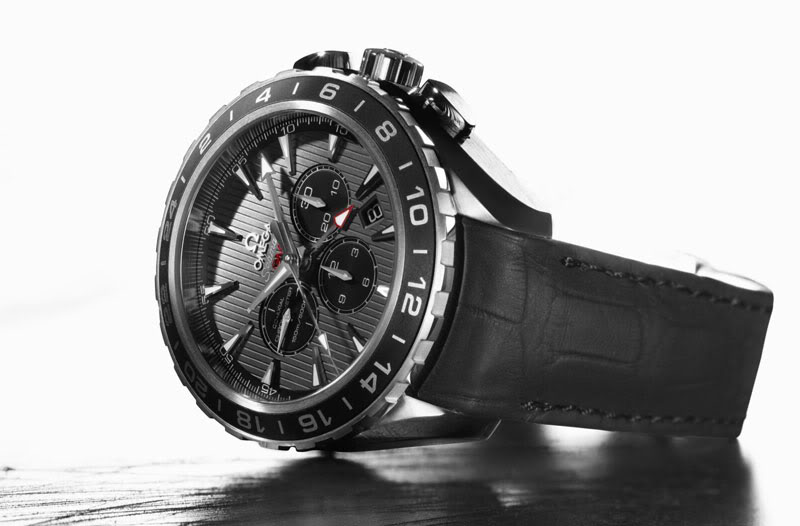New Omega Seamaster Aqua Terra Co-Axial GMT Chronograph

Omega released a new model in the Seamaster Aqua Terra collection, the Seamaster Omega Seamaster Aqua Terra GMT Chronograph. Of course another Omega with their famous co-axial escapement, but did you know how the co-axial escapement ended up in Omega’s watches?
Since the introduction of the new Seamaster Aqua Terra collection, these watches have the new co-axial escapement. So does the new Seamaster Aqua Terra Co-Axial GMT Chronograph. Like the rest of the collection it has the same tuxedo striped dial, or like Omega says a dial with a “teak concept”. According to Omega this ‘teak concept’ reminds of the wooden deks of luxury boats. Ah well… marketing is a trade apart. 🙂

The Aqua Terra Co-Axial GMT Chronograph features the co-axial calibre 3603 with a free sprung balance. The movement has a column-wheel chronograph mechanism and is COSC certified. Besides the chronograph function it is also equipped with a date function and 24 hour GMT hand.
The Seamaster Aqua Terra co-axial chronograph is available in four case materials and comes either with bracelet or alligator strap. The 44 mm case is water resistant to 150 meters and has a domed sapphire crystal with anti-reflective treatment on both sides, as well as see through caseback.
The Co-Axial Escapement
A nice thing to know is that the co-axial escapement Omega uses in most watches of their collection, is developped by mr. George Daniels. Daniels, an English watchmaker, who made name as master of the Clockmakers’ Company of London and has been awarded their Gold Medal, a rare honour. He is actually one of the few living watchmakers who can create a complete watch by hand.

After much experimenting he patented a type of watch escapement called the co-axial escapement. The friction in this escapement is reduced to a vey low level, so there’s no need to oil the escapement. Oil has the nasty habbit of thickening when it gets older, which influences the reliability of the movement.
After completing the designs in 1974 Daniels tested the co-axial escapement and it proved to be extremely positive. This later earned him the prestigious Tompion Medal; at that time only the fifth ever to be awarded. After the co-axial escapement was finished, the Swiss watch industry did not immediately adopt this award winning and brilliant idea. Nope… it took 25 years before he was able to sell it to one of the leading Swiss watch brands. Curtis Thomson wrote an interesting article about the different watches Daniels used to prove his co-axial escapement.
As part of the contract, Omega would provide the Daniels’ workshop with 50 co-axial movements. He intended to use them for a series of watches to be sold under his name, Daniels London. Daniels asked one of his students, Roger Smith, if he’d be willing to move to the Isle of Man and assist in the making of the series, to which he agreed.
This became the Millennium Watch, and its movement is based on Omega’s caliber 2500, which is based on their caliber 1120, which is, in turn, based on ETA’s 2892-A2. Are you still with me?
The Millennium Watch has several modifications to the Omega ebauche (is an unassembled movement). The calendar work, dial, hands and the automatic rotor where all created in Daniels’ workshop.
It should be noted that the Millennium Watch shown here is Roger’s personal watch. It is the only Millennium Watch with ‘Daniels-London’ on the dial.




2 responses
Fascinating article. I’ve always wondered about the significance of the co-axial movement.
Hi Lexcen,
Now i understand myself what the advantages are, i am also doubting the effectiveness of the co-axial escapement these days. I’m not sure but i think it comes down to this… Modern synthetic oils don’t get sticky anymore… so only the absense of oil as a slow down factor might be an advantage.
Cheers
Frank